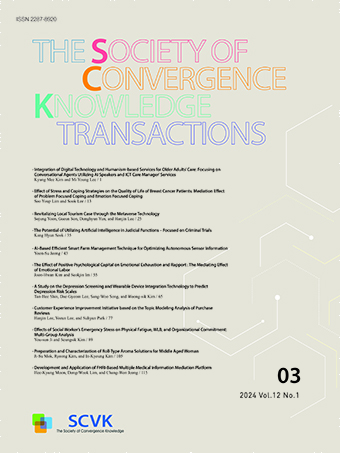Research Article
Abstract
References
Information
본 연구는 감성기반 챗봇(Chatbot) ‘헬로우봇’에 관한 소셜 미디어(social media) 빅데이터를 분석하여 다음의 결과를 도출했다. 첫째, 분석에서 ‘친구’가 상위단어이다. 즉 우리사회에서 관계성과 친밀함의 욕구가 인공지능 챗봇에게 향하고 있다. 또한 인공지능 캐릭터들이 현대판 심리상담사의 기능도 수행한다. 기존의 심리 상담이 쉽고 편리하게 대중 속으로 스며들고 있으나 인간관계에서의 철수 경향은 경계해야한다. 둘째, SNS 기반의 개인화된 공간과 시간에 대한 추구가 있다. 셋째, ‘오늘’이라는 단어는 젊은 세대들의 내일의 절망과 오늘에 만족해야하는 현실을 암시한다. 넷째, 헬로우봇의 점성술, 타로 같은 판타지 콘텐츠의 인기는 젊은 층의 미래의 불안을 암시한다. 불안을 달래주는 고대 샤먼 역할을 타로챗봇 라마마가 이어받았다. 즉 인공지능 기술력이 판타지 콘텐츠와 융합하면서 지나치게 문명화된 현대사회에 판타지를 더하며 불안을 다루고, 정신의 균형을 잡아준다.
his study analyzed social media big data about emotion-based Chatbot ‘Hellobot’ and derived the following results. First, ‘friends’ are the top words in the analysis. In other words, the desire for relationship and intimacy that modern people have turned to AI chatbots. AI characters also perform modern psychological counselors. Conventional psychological counseling is easily and conveniently penetrating the public, but be wary of withdrawal from human relationships. Second, there is the pursuit of personalized space and time SNS-based. Third, the word ‘today’ suggests the despair of tomorrow and the reality of being satisfied with today. Fourth, the popularity of fantasy content, such as HelloBot’s astrology and tarot, suggests future anxiety for young people. The tarot chatbot Ramama took over as an ancient shaman to soothe anxiety. That is, artificial intelligence technology merges with fantasy contents, adds fantasy to the overly civilized modern society, deals with anxiety and balances the mind.
- 송동호, 신지애, 박영택, 박세영, 한형상, “미래지식기반 사회의 예측과 인공지능(AI)기술”, KEIT PD issue report. 제 16권 제3호, pp.29-51, 2016.
- 송선영. “의료용 케어로봇과 환자 간의 서사와 공감 관계의 가능성”, 인간·환경·미래, 제 18권. pp. 49-76, 2017.
- 김유리. “제4차산업혁명의 정의: 제4차 산업혁명 시대와 서울 미래교육의 실제“, 서울교육, 제.58권 제3호, pp.129-135, 2016.
- IRS Global 편저. “4차 산업혁명 시대의 지능형 로봇 분야별 기술개발 동향과 시장 전망”, IRS Global, 2018.
- 노아영, 김영준, 김형수, “인공지능을 활용한 다중 생체신호 분석 기반 스마트 감정 관리 시스템”, 전기전자학회논문지, 제21권 제4호, pp.397-403, 2017.
- 윤현중, 정성엽. “자폐스펙트럼장애 진단 및 치료를 위한 감성 컴퓨팅 기술 동향 분석”, 한국감성과학회, 제13권 제3호, pp. 429-440, 2010.
- Dersingh, Anand., Srisakulpinyo,Prerapat., Rakkarn, Sakchai., Boonkanit, Prin., “Chatbot and Visual Management in Production Process”, 대한전자공학회, pp.274-277, 2017.
- 김보겸, 김태욱, 김호연, 황경호, 김교근, 강지연, 조창대, “IBM Watson Assistant를 활용한 인공지능 온라인 쇼핑몰 챗봇 개발”, 한국통신학회 학술대회논문집, 제11호, pp. 628-629, 2018.
- 김용기, 이창희, 이정민, “쇼핑몰 지능형 챗봇의 자연어 처리를 위한 패션쇼핑 개체명 인식 사전 구축” 대한산업공학회 춘계학술대회논문집, 제4호, pp. 2744-2749, 2018.
- 강영, 김기쁨, 안가현, 이만희, 강승석, “ 챗봇을 통한 쇼핑몰 통합 고객센터 ”, 한국정보기술학회 하계종합학술발표논문집, 제6호, pp.239-241, 2017.
- 김유정, 한상규, 윤종묵, 허은영, 김정훈, 이중식, “챗봇 에이전트 정체성(identity)에 따른 사용자의 인식 및 행동 차이에 대한 연구” 한국HCI학회 논문지, 제12권 제4호, pp. 45-55, 2017.10.17210/jhsk.2017.11.12.4.45
- Jenkins, M.C., Churchill, R., Cox, S., Smith, D., “Analysis of User Interaction with Service Oriented Chatbot Systems”, Lecture Notes in Computer Science, 제 4552호, pp. 76–83, 2007.10.1007/978-3-540-73110-8_9
- 안아주, 이현정, 이중식. “Human-AI bot 인터랙션 분석 : AI bot 에게 해결을 바라는 사용자의 희망사항(wish) 수집 및 분석”, 한국HCI학회 학술대회, pp. 346-349, 2017.
- 최수민, 최용순. “모바일 메신저 기반 인공지능 챗봇의 상품 주문결제 인터페이스 연구”, 한국HCI학회 학술대회, pp. 237-240, 2017.
- Atay, Christina, Ireland, David, Liddle, Jacki, Wiles, Janet, Vogel, Adam, Angus, Daniel, Bradford, Dana, Campbell, Alana and Rushin, Olivia. “Can a smartphone-based chatbot engage older community group members? The impact of specialised content”, Alzheimer’s & Dementia, Vol.12, no.7, pp. 1005-1006, 2016. 10.1016/j.jalz.2016.06.2070
- 윤현중, 정성엽. “자폐스펙트럼장애 진단 및 치료를 위한 감성 컴퓨팅 기술 동향 분석”, 한국감성과학회, 제13권 제3호, pp.429-440, 2010.
- Fryer, Luke K. Ainley, Mary, Thompson, Andrew. “Stimulating and sustaining interest in a language course:An experimental comparison of Chatbot and Human task partners”, Computers in human behavior, no. 75, pp. 461-468, 2017.10.1016/j.chb.2017.05.045
- Jia, J. “CSIEC: A computer assisted English learning chatbot based on textual knowledge and reasoning”, Knowledge-based systems. Vol.22, no.4, pp. 249-255, 2009.10.1016/j.knosys.2008.09.001
- Bigham, J.P., Aller, M.B., Brudvik, J.T., Leung, J. "Inspiring Blind High School Students to Pursue Computer Science with Instant Messaging Chatbots". ACM Inroads. Vol. 40, no. 1, pp. 449-453, 2008.10.1145/1352322.1352287
- 양민철, 이연수, 임해창. “예제 기반 챗봇을 위한 기계 학습 기반의 발화 간 유사도 측정 방법”, 한국산학기술학회 논문지, 제11권 제8호, pp.3021-3027, 2010.10.5762/KAIS.2010.11.8.3021
- 정상윤, 윤석영, 박충식. “챗봇 제작을 통한 SW교육방안”, 한국지능정보시스템학회 학술대회논문집, pp.143-145, 2017.
- Allison, D. “Chatbots in the library: is it time?”, Library hi tech, Vol.30, no.1, pp. 496-522, 2012.10.1108/07378831211213238
- Kerly, A., Hall, P., Bull, S., “Bringing chatbots into education: Towards natural language negotiation of open learner models”. Knowledge-based systems. Vol. 20, no.2, pp.177-185, 2007.10.1016/j.knosys.2006.11.014
- Kerly, A., Bull, S. “The Potential for Chatbots in Negotiated Learner Modelling: A Wizard-of-Oz Study”, Lecture Notes in Computer Science, Vol. 4053, pp. 443-452, 2006. 10.1007/11774303_44
- Han, Vince. “Are Chatbots the Future of Training?”, Talent development, Vol. 71, no.9, pp.42-46, 2017.
- 송선영. “의료용 케어로봇과 환자 간의 서사와 공감 관계의 가능성”,인간·환경·미래, 제18권, pp.49-76, 2017.
- 전덕빈, 조상균. “정신질환 증상 네트워크의 구조 및 위상 변화를 이용한 인공지능 진단모형 개발 및 치 료에의 응용”, 한국경영과학회 논문집, pp. 295-299, 2017.
- 성영모. 박승민, 오제은. “청소년자살예방을 위한 인공지능기반 상담시스템의 구성 요소연구”, 청소년학연구, 제19권 제11호, pp. 271―297, 2012.
- 강태덕. 홍성태. “AI/ChatBot 기반 Self-service technology 도입과 이용에 영향을 미치는 요인에 관한 연구”, 한국항공경영학회 춘계학술대회, pp.47-48, 2017.
- Roehrig, Charles. “Mental Disorders Top The List Of The Most Costly Conditions In The United States: $201 Billion”, Health Affairs, Vol.35, no.6, 2016.10.1377/hlthaff.2015.1659 27193027
- 송선영. “의료용 케어로봇과 환자 간의 서사와 공감 관계의 가능성”, 인간·환경·미래, 제18권, pp. 49-76, 2017.
- https://www.psychiatry.org.
- http://biz.chosun.com/site/data/html_dir/2017/08/25/2017082502644.html.
- 이동훈, 김주연, 김진주, “온라인 심리치료의 가능성과 한계에 대한 탐색적 연구”, 한국심리학회지:상담 및 심리치료, 제27권 제3호, pp.543-582, 2015.
- https://thingsflow.com/
- 이화정. “프로스테미니즘 드라마에 대한 수용자의 선호연구”, 기초조형학 연구, 제13권 제2호, pp. 433-443, 2012.
- 조항제. “미디어 문화연구의 질적 방법론”, 컬처룩, 2015.
- McKinsey. Big Data: The next frontier for innovation, competition, and productivity. McKinsey Global Institute. 2011.
- http://www.textom.co.kr/home/sub/about.php?pnm=1cm.webdaily.co.kr/view.php?ud=20181210092439205401286bacad_7&md=2019080715_H
- www.jobnjoy.com/portal/job/special_view.jsp?nidx=353582hellobot.co
- www.tumblbug.com/
- Kim, H. S. “An exploratory study on the semantic network analysis of food tourism through the big data”, Culinary Science & Hospitality Research, Vol.23, no.4, pp.22-32, 2017.10.20878/cshr.2017.23.4.003003003
- 강준만. “대중문화의 겉과 속”, 인물과 사상사, 2013.
- 김난도, 전미영, 이향은, 최지혜, 이준영, 김서영, 이수진, 서유현, 권정윤. “트렌드코리아 2019”, 미래의 창. 2019.
- 김헌식, “대중문화 심리읽기”, 울력, 2010.
- Winckel, Erna Van De. “융의 심리학과 기독교 영성”, 김성민 역, 한국심리치료연구소, 2010.
- Marshall McLuhan and Quentin Fore. “Medium is the Massage: An Inventory of Effects” Bantam, 1967.
- 안명숙. “청소년의 판타지 텍스트에 대한 공감요소 연구”, 청소년시설환경, 제15권 제2호, pp. 75-85, 2017.
- https://news.mt.co.kr/mtview.php?no=2018072421405266
- Publisher :The Society of Convergence Knowledge
- Publisher(Ko) :융복합지식학회
- Journal Title :The Society of Convergence Knowledge Transactions
- Journal Title(Ko) :융복합지식학회논문지
- Volume : 7
- No :3
- Pages :65-75
- DOI :https://doi.org/10.22716/sckt.2019.7.3.035




 The Society of Convergence Knowledge Transactions
The Society of Convergence Knowledge Transactions







